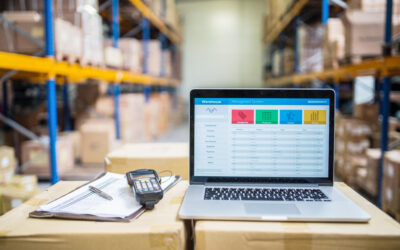How To Create a Fixed Asset Tracking Register
An asset register gives your business clear and instant benefits. It is essential for a business to have an asset register as they’re your first defence against many fines and many sunk or lost costs.
With an effective asset register, your business can monitor and control what it owns with a lot more ease. This is because you have a lot more visibility over where assets are, what they are, and who has them.
Therefore, with an asset register, you:
- Save time
- Save money
- Lose fewer assets
- Purchase fewer duplicates
- Avoid accounting risks
- Increase accountability
These benefits are just the tip of the iceberg, though, as you can save weeks a year in asset tracking operations. Your ROI in costs will depend on your assets, but one lost laptop not only stings but it slows down work for someone, overall bringing down productivity.

What is Fixed Asset Tracking?
Fixed asset tracking refers to proper supervision and control over an organisation’s tangible assets, such as equipment, machinery, furniture, and other stationery, which must be accounted for to guarantee they are used effectively. Every business, regardless of size, needs this, as fixed assets represent a huge percentage share of a company’s investments and capital.
Fixed asset tracking involves tagging every individual asset through unique identification, normally in the form of serial numbers or barcodes, and maintaining an up-to-date record of the respective locations, status, maintenance history, and depreciation. This information is usually held in some central database or software that can easily be accessed whenever it is required.
Fixed assets monitoring allows for better utilisation of an investment’s life, reduced repair expenses, and insurance and regulatory compliance.
Methods and technologies for tracking fixed assets range from manual spreadsheets to barcode scanning and other approaches like RFID or QR-code asset tracking, which we will be discussing below. Of course, all of these practices have associated advantages and limitations, which are related to the size and complexity of any given organisation.
Why You Shouldn’t Use Spreadsheets

The first question when you’re creating an asset register is whether or not you should use a spreadsheet. It’s tempting, as spreadsheets are free and easily accessible.
There are far too many reasons why you should never use a spreadsheet for your asset register. First and foremost, the lack of malleability and control means that using a spreadsheet will cost you money.
This is because of the high likelihood of ghost and zombie assets and other dangerous gaps in fixed asset accounting. If you think about it, a spreadsheet is a snapshot. So, every time an asset moves or changes hands, your asset register is out of date.
Then, count the number of assets you have and multiply it by the number of fields you want to record for your assets, such as service dates and invoice numbers. This is the number of cells you need to keep track of. Given this inconvenience of information overload, it’s no wonder spreadsheets are unreasonable, unmalleable and unwieldy, let alone unrelenting in the amount of work they cause.
Using Fixed Asset Register Software
Therefore, the best way to create an asset register is by using fixed asset register software. Fixed asset register software works by allowing you to log your assets as unique profiles.
Similar to social media in this sense, you can log each of your laptops and add unique data to them. This is critical because if one laptop has a problem, you need to know which one, where it is and who has it.
Instead of using cells and rows, you create an asset register by building asset profiles and actually interacting with equipment rather than using intangible communications between objects.
Then, once your data has been added and is getting monitored and updated, you can run reports on it and export it as a PDF or Excel sheet. This way, you can create the benefits of a data snapshot without having to then manage it in a difficult way.
What is an RFID Asset Tracking System?

Radiofrequency identification (RFID) is a type of wireless technology that combines radio waves to read embedded data. Modern RFID systems have been around for 50 years, and technical enthusiasts have identified their advantages.
RFID Benefits
- Enhanced Security
RFID technology tracks and monitors assets in real time, offering a better degree of security. It also offers exact location data for tagged objects, lowering the danger of theft and loss.
- Convenient to Use
Like barcodes, RFID is accessible to use despite being a slightly more complicated technology.
- Cost Savings
Although the initial outlay in RFID technology can be large, over time, the long-term savings from lower labour costs, fewer mistakes, and better inventory control can drastically cut expenses.
- Increased Visibility
RFID increases companies’ awareness of their operations, allowing them to track assets and goods in real time. This higher awareness depends on more responsive supply chain management and improved decision-making.
- Faster Data Collection
Technical enthusiasts constantly modify RFID to ensure multiple uses of one RFID card. This enables them to make their vision a reality and provide people with multifunctional technologies.
- Improved Customer Experience
Unlike barcodes, which must be scanned individually, RFID tags may be read automatically and concurrently in vast numbers. This accelerates data collection procedures, especially in big warehouses or during inventory audits.
Today, RFID users can embed different command prompts into one key card and still have different access policies for each prompt.
What is a QR code?

A QR code or quick response code, generated by a dynamic QR code generator, is a type of two-dimensional bar code invented in 1994 by Denso Wave. Its two-dimensional function allows for scanning of QR codes faster than conventional one-dimensional bar codes. These QR codes are now widely used in business, health care, transportation, and education. Because they are ubiquitous, they are placed in posters, brochures, flyers, magazines, window panes, newspapers, product labels, business cards, and social media messages.
Advantages of QR-Code Asset Tracking System
- Cost-effectiveness
QR codes are inexpensive to manufacture. Since they do not require money or additional resources to create, QR codes are economical for small businesses and start-ups.
- Easy to create
Unlike with RFID tags, QR codes are very easy to create and use. Many QR code generators are available online, so people can quickly learn how to create and use QR codes.
- Can store various multimedia formats
Modern QR code technology can support various multimedia formats, including URLs, documents, images, audio and video files, emails, and access to WiFi.
- Have higher resistance to damage
By studying the features of RFID and QR codes, we can see that QR codes can resist significant physical damage due to their high error correction function. Because of this, it’s often possible to still scan QR codes even with damage to them.
- Mobile
One of the great things about QR codes is that people can scan them with their smartphones and access content online. This ensures that the information in the QR code is within reach.
Using Fixed Asset Tags
Fixed asset tags improve your asset register as they make actual interactions between assets. Asset tags are physical tags that you just stick onto your gear and use to link profiles to equipment.
So, every time you scan an asset’s tag – the asset’s profile will open. Therefore, if you notice an asset has an issue, you simply need to scan the tag and report the issue. Your maintenance team will be notified of the change.
And, every time you scan an asset’s tag, the last seen location updates, as well as the user who scanned the tag and the exact time of scanning. This gives you a neat, automatic log of asset interactions and a handy audit trail in tandem.
So, not only does logging assets on asset tracking software create your asset register for you, but it also automates many of the edits and updates that you’ll need to log.
Deploying Asset Management Operations
When you’re deploying asset management systems there are a suite of customisable, effective, and helpful features that let you log and manage assets. This logging process paves the way for a better asset register and better asset tracking. Sometimes, this can be daunting, which is why effective support is helpful if you need it. Fixed asset register software is built to be intuitive, but sometimes, there are specific questions, such as what you can use your asset register for.
With itemit, not only you do get a substantial, high ROI, but you also gain effective, fast, and helpful support to allow you to set up faster. This, in turn, saves you even more money and, more importantly, time.
To find out how Itemit can help you with all of your asset tracking needs, from IT asset management to fixed asset tracking to equipment tracking, you can contact the team at team@itemit.com. You can also fill in the form below to start your very own 14-day free trial.
Frequently Asked Questions
What Is Fixed Asset Tracking, and Why Is It Important for Businesses?
Tracking fixed assets entails overseeing a company’s tangible possessions, such as machinery and equipment, as they progress through their life span. Accurate record-keeping, compliance, and optimising asset use are crucial for businesses to prevent losses, cut costs, and enhance efficiency.
How Does an Asset Tracking System Work?
A system for tracking assets utilises techniques such as barcodes, RFID tags, and QR codes to collect data about assets. This information is then saved in a central database. This system enables businesses to monitor asset location, status, and maintenance in real time, ensuring precise and effective management.
What Are the Benefits of Using Fixed Asset Management Software?
Fixed asset management software automatically tracks assets, decreases errors, and cuts costs by identifying assets that are not being used effectively. It guarantees adherence, organises upkeep, and offers live asset tracking, resulting in improved decision-making and enhanced productivity.
How Can RFID and QR Code Asset Tracking Systems Improve Asset Management?
RFID and QR code systems enhance asset management by allowing fast and precise asset recognition. RFID tags allow for remote reading, whereas QR codes provide immediate access to asset information. Both technologies improve the effectiveness and dependability of tracking.
What Features Should I Look for in the Best Fixed Asset Tracking Software?
Search for software that is easy to use, compatible with your current systems, and grows alongside your company. Key components comprise live monitoring, robust reporting, upkeep oversight, and backing for either RFID or QR code technology for effective asset control.
How To Create a Fixed Asset Tracking
Choose a better way to track your assets
Start your free 14-day trial now
Instant access. No credit card details required.
You can also start your 14-day free trial by filling out the form below, or you can contact us at team@itemit.com or at 01223 421611.
Or, you can check out these blogs:
What Are the Best Asset Management Tracking Tools?
3 Ways Fixed Asset Tracking Software Saves you Time and Money
How to Track Maintenance with Heavy Equipment Maintenance Software
Latest posts
itemit Blog
Tips, guides, industry best practices, and news.
Latest posts
itemit Blog
Tips, guides, industry best practices, and news.
Related articles
How to Optimise Product Inventory Management
Learn how to optimize product inventory management with effective strategies, a product inventory management system, and best practices for efficiency.
Buffer Stock in Inventory Management: How It Optimizes Supply Chain Efficiency
Learn the meaning of buffer stock, its role in inventory management, and how it optimizes supply chains. Explore strategies and tools for effective stock management.
What Is an Online Inventory Management System?
Discover what an online inventory management system is, how it works, and why it’s essential for efficient inventory tracking and business success.


